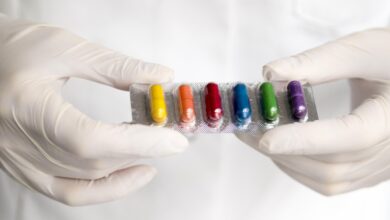
Introduction to Programmatic Advertising in Pharma
The pharmaceutical industry is embracing digital transformation, and programmatic advertising is at the forefront of this change. In this section, we will explore the fundamentals of programmatic advertising and its progression within pharma.
Defining Programmatic Advertising
Programmatic advertising refers to the automated buying and selling of online advertising space. It utilizes sophisticated algorithms and real-time data to place ads in front of specific audiences across various digital platforms. This method of advertising offers pharma marketers the ability to purchase ad space efficiently, ensuring that their messages reach the right people at the right time.
The core components of programmatic advertising include:
- Demand-Side Platforms (DSPs): These platforms enable advertisers to buy ad space through automation.
- Supply-Side Platforms (SSPs): Publishers use these platforms to sell their available ad space to the highest bidder.
- Data Management Platforms (DMPs): These systems collect and analyze large sets of data to target specific audience segments.
- Ad Exchanges: Digital marketplaces where DSPs and SSPs interact to trade ad space.
The efficiency and precision of programmatic advertising make it a valuable tool in the arsenal of pharma marketing automation strategies.
Evolution of Advertising in Pharma
Advertising in the pharmaceutical sector has undergone significant changes over the past few decades. Traditional methods such as print ads, TV commercials, and direct mailing have given way to more dynamic and interactive digital channels.
| Era | Advertising Method | Characteristics |
|---|---|---|
| 1980s-1990s | Print and TV | Mass marketing, limited targeting |
| 2000s | Digital Ads | Email campaigns, banner ads |
| 2010s | Social Media & SEO | Enhanced engagement, targeted content |
| 2020s | Programmatic Advertising | Precision targeting, real-time bidding, measurable impact |
As the industry evolves, programmatic advertising is becoming an integral part of marketing technology in pharmaceuticals, offering a level of granularity and measurement that was previously unattainable. The shift from broad-spectrum advertising to a more focused approach aligns with the overall trend towards data-driven marketing in pharmaceuticals, where insights derived from data analytics shape marketing strategies.
Additionally, AI in pharmaceutical marketing has begun to play a pivotal role in programmatic advertising, enhancing the ability to predict user behavior and optimize ad campaigns for maximum impact. The adoption of programmatic advertising in pharma not only reflects the industry’s innovation but also its commitment to reaching healthcare professionals and patients in the most effective ways possible.
The Intersection of Martech and Adtech in Pharma
The pharmaceutical industry is witnessing a transformative convergence of marketing technology (martech) and advertising technology (adtech). This intersection is creating new opportunities for pharma marketers to reach their audience more effectively.
Increasing Precision in Pharma Marketing
The integration of martech and adtech allows for increased precision in pharma marketing efforts. With advanced analytics and automated platforms, marketers can identify and segment their target audiences with greater accuracy. This precision ensures that marketing campaigns are more relevant to the individuals they reach, which can lead to improved campaign performance and a higher return on investment.
Leveraging pharma marketing automation, marketers can automate repetitive tasks and refine their focus on strategy and creative development. Automation tools can manage large datasets to deliver insights that drive strategic decisions. These insights enable pharma companies to tailor their messaging and positioning to resonate with specific patient demographics, healthcare providers, and other stakeholders within the healthcare ecosystem.
Enhancing Customer Engagement with Data
Data is at the heart of the martech and adtech convergence, providing a wealth of information that pharma marketers can use to enhance customer engagement. By utilizing data from various touchpoints, marketers can gain a comprehensive view of the customer journey and identify the most impactful moments for engagement.
The use of data-driven marketing in pharmaceuticals allows for the creation of personalized experiences that can lead to deeper connections with audiences. These personalized experiences are not just about delivering the right message at the right time, but also about providing value through educational content, support resources, and tailored communications that meet the unique needs of each customer segment.
Here is an example of how data segmentation can enhance customer engagement:
| Customer Segment | Engagement Strategy |
|---|---|
| Patients | Personalized disease education and medication reminders |
| Healthcare Providers | Tailored clinical data and treatment guidelines |
| Payers | Customized value propositions and cost-effectiveness data |
Through the strategic use of marketing technology in pharmaceuticals, marketers can leverage these data insights to optimize customer interactions and build lasting relationships. Additionally, the adoption of cutting-edge technologies such as AI in pharmaceutical marketing is set to further enhance the ability of marketers to predict customer behaviors and preferences, leading to even more effective engagement strategies.
Advantages of Programmatic Advertising
Programmatic advertising has revolutionized the way pharma marketers approach audience targeting and engagement. This technology-driven method offers several compelling advantages that enhance marketing efficiency and effectiveness.
Real-time Bidding and Efficiency
Real-time bidding (RTB) is a hallmark of programmatic advertising, enabling advertisers to purchase ad inventory instantaneously through automated auctions. RTB increases efficiency by allowing for the placement of ads in front of the right audience at the optimal time, without the need for traditional, time-consuming negotiations.
| Process | Time Taken (Traditional) | Time Taken (RTB) |
|---|---|---|
| Ad Space Booking | Days | Milliseconds |
| Campaign Launch | Hours to Days | Seconds |
The efficiency of RTB not only streamlines the ad buying process but also reduces overhead costs associated with manual ad placement. Furthermore, it allows pharma marketers to reallocate resources to strategy and creative development, enhancing the overall marketing effort.
Targeting and Personalization
One of the most significant advantages of programmatic advertising in pharma is the ability to target specific demographics, behaviors, and interests with unparalleled precision. Advanced algorithms analyze vast sets of data to identify the ideal audience for a particular pharmaceutical product or service.
Through programmatic platforms, marketers can segment audiences based on various factors, ensuring that their message resonates with individuals who are most likely to be affected by their campaigns. This personalized approach not only improves the relevance of ads but also increases the probability of engagement and conversion.
| Targeting Dimension | Examples |
|---|---|
| Demographics | Age, Gender, Income |
| Geography | Region, City, Zip Code |
| Behavior | Browsing History, Purchase Patterns |
| Intent | Real-time actions, Keyword Activity |
Measuring and Optimizing Campaigns
Programmatic advertising provides marketers with rich analytics and real-time performance data, enabling them to measure the impact of their campaigns precisely. With these insights, marketers can make informed decisions to optimize their strategies for better outcomes.
The ability to track key performance indicators (KPIs) such as click-through rates (CTRs), conversion rates, and return on ad spend (ROAS) allows for continuous refinement of campaigns. Marketers can test different creatives, messaging, and channels to determine the most effective combinations.
| KPI | Importance |
|---|---|
| CTR | Gauges ad engagement |
| Conversion Rate | Assesses effectiveness in driving actions |
| ROAS | Evaluates financial performance |
By leveraging marketing technology in pharmaceuticals, particularly programmatic advertising, pharma marketers can not only reach but also actively engage their target audiences in more meaningful ways. The integration of pharma marketing automation with programmatic tactics ensures that campaigns are not only efficient but also data-driven, paving the way for more personalized and impactful marketing approaches. As the field continues to evolve, the role of AI in pharmaceutical marketing is expected to further enhance the capabilities of programmatic advertising, making it an indispensable tool in the marketer’s arsenal.
Overcoming Challenges in Pharma Advertising
As pharmaceutical marketers turn to programmatic advertising to reach their target audience more effectively, they must navigate a complex landscape of challenges. Regulatory compliance and privacy concerns are at the forefront of these challenges, along with the essential task of fostering trust in an industry that is under intense public scrutiny.
Regulatory Compliance and Privacy Concerns
The pharmaceutical industry is subject to stringent regulations designed to ensure consumer safety and truthful advertising. Programmatic advertising in pharma must comply with regulations such as the Food and Drug Administration (FDA) guidelines in the United States, which dictate how prescription drugs can be marketed and to whom.
Moreover, privacy concerns are especially salient in an era where consumer data is a valuable commodity. Pharmaceutical marketers must ensure that their programmatic advertising strategies are not only compliant with regulations like the Health Insurance Portability and Accountability Act (HIPAA) but also with consumer data protection laws, such as the General Data Protection Regulation (GDPR) for European audiences and the California Consumer Privacy Act (CCPA) in the United States.
Navigating these regulations requires a robust understanding of both legal and ethical considerations. Marketers should collaborate closely with legal teams to establish protocols that protect consumer information and ensure all advertising campaigns are fully compliant.
Creating Trust with Programmatic Advertising
Trust is a critical component in the relationship between pharmaceutical companies and their customers. With programmatic advertising’s ability to target specific demographics, there is a risk of appearing intrusive or exploitative if not managed sensitively.
To build and maintain trust, transparency in advertising practices is vital. Marketers should prioritize clear communication about how data is being used and the benefits it can provide to the consumer, such as personalized healthcare information and relevant product recommendations.
Engaging with consumers on a personal level can also help build this trust. By using programmatic advertising to provide valuable content and support, rather than just selling products, pharmaceutical companies can position themselves as allies in the consumer’s healthcare journey.
Staying abreast of emerging technologies and trends in programmatic advertising is essential for maintaining the balance between effective marketing and consumer trust. The integration of AI in pharmaceutical marketing can help refine targeting strategies and optimize campaigns, but it must be leveraged judiciously to avoid overstepping boundaries.
| Challenge | Strategy |
|---|---|
| Regulatory Compliance | Collaborate with legal teams; Stay updated on laws |
| Privacy Concerns | Implement data protection protocols; Comply with GDPR, HIPAA, CCPA |
| Building Trust | Practice transparency; Provide valuable content |
Implementing these strategies requires a dedicated effort from pharmaceutical marketers to stay informed about the evolving landscape of pharma marketing automation and data-driven marketing in pharmaceuticals. By addressing these challenges head-on, and ensuring a thoughtful approach to programmatic advertising, the pharma industry can harness its full potential while upholding the highest standards of consumer care and trust.
Implementing Programmatic Advertising in Pharma
The implementation of programmatic advertising within the pharmaceutical industry requires a strategic approach and the assembly of a skilled team. By addressing these two foundational components, pharma marketers can leverage the full potential of programmatic advertising to enhance their marketing efforts.
Developing a Programmatic Strategy
Creating an effective programmatic strategy involves several crucial steps. Initially, it’s essential to define clear campaign objectives that align with the overall marketing goals of the pharmaceutical company. These objectives might include increasing brand awareness, driving patient engagement, or promoting new treatments.
Next, pharma marketers must identify their target audience by analyzing patient data, prescribing patterns, and healthcare professional (HCP) preferences. This understanding allows for the development of precise targeting criteria, which is a cornerstone of programmatic advertising.
Budget allocation is another critical aspect of the strategy. Marketers must decide how much to invest in programmatic channels versus traditional advertising methods. This decision often hinges on the analysis of past campaign performance data and industry benchmarks.
A successful programmatic advertising strategy in pharma also requires a robust technology infrastructure. This includes choosing the right Demand Side Platform (DSP) and ensuring it integrates seamlessly with existing pharma marketing automation tools.
Finally, it’s paramount to outline a compliance framework that adheres to industry regulations and data privacy standards. The strategy should include guidelines for message creation, audience targeting, and data usage that comply with the stringent requirements of the pharmaceutical sector.
| Step | Key Consideration |
|---|---|
| Objective Setting | Align with marketing goals |
| Audience Identification | Utilize patient and HCP data |
| Budget Allocation | Compare programmatic vs. traditional spend |
| Technology Infrastructure | Select and integrate the right DSP |
| Compliance | Establish a regulatory-adherent framework |
Building the Right Team and Skillset
To navigate the complexities of programmatic advertising in pharma, assembling a team with the right expertise is critical. This team should have a diverse range of skills, from data analysis to creative development and regulatory knowledge.
Essential roles within the team might include:
- Data Analysts, who can interpret the wealth of data generated by programmatic campaigns and glean actionable insights.
- Media Buyers, who understand the nuances of real-time bidding and can effectively manage programmatic buying platforms.
- Creative Specialists, who can craft compelling ad messages that resonate with the target audience while remaining compliant with industry regulations.
- Compliance Officers, who are well-versed in the legal aspects of pharmaceutical advertising and can ensure all campaigns are up to standard.
The team should also have a thorough understanding of marketing technology in pharmaceuticals, as well as the ability to implement data-driven marketing in pharmaceuticals.
To stay ahead of the curve, continuous learning and development are essential. This might involve regular training sessions on the latest programmatic tools and techniques, as well as workshops on emerging topics like AI in pharmaceutical marketing.
| Role | Skills Required |
|---|---|
| Data Analyst | Data interpretation, insight generation |
| Media Buyer | Real-time bidding, platform management |
| Creative Specialist | Ad creation, audience engagement |
| Compliance Officer | Regulatory knowledge, risk management |
Developing a programmatic strategy and building the right team are fundamental steps towards harnessing the power of programmatic advertising in pharma. With a well-thought-out approach and a skilled team in place, pharma marketers are well-positioned to capitalize on the advantages of this modern advertising paradigm.
Future of Programmatic Advertising in Pharma
The landscape of programmatic advertising in pharmaceuticals is continuously evolving, with new innovations and trends shaping the way pharma marketers connect with their audiences. In this dynamic environment, staying ahead of the curve is crucial for those looking to leverage the full potential of programmatic advertising.
Innovations and Trends
In the realm of programmatic advertising, pharma marketers can expect to see a wave of innovations that focus on enhancing personalization, ensuring privacy, and increasing the efficiency of ad spends. One significant trend is the shift towards more privacy-centric approaches in response to increasing regulations and consumer concerns about data usage.
Another trend is the adoption of omnichannel strategies, allowing for seamless marketing efforts across various digital platforms. This approach ensures that the messaging is consistent and personalized, regardless of the channel.
Emerging technologies, such as voice search and programmatic audio, are also gaining traction, offering new avenues for reaching target audiences through non-traditional mediums. Additionally, the use of blockchain technology is being explored to bring transparency and accountability to ad transactions.
The table below highlights key programmatic advertising trends in pharma:
| Trend | Description |
|---|---|
| Privacy-Centric Advertising | Increased focus on user privacy and compliance with data protection regulations. |
| Omnichannel Strategies | Integration of advertising efforts across multiple digital platforms. |
| Voice and Audio Advertising | Leveraging voice search and programmatic audio to reach consumers. |
| Blockchain for Transparency | Using blockchain technology to ensure transparent ad transactions. |
For a deeper insight into how these trends are reshaping the pharma marketing landscape, explore our article on marketing technology in pharmaceuticals.
The Role of Artificial Intelligence and Machine Learning
Artificial intelligence (AI) and machine learning (ML) are at the forefront of driving programmatic advertising forward. These technologies enable pharma marketers to analyze vast amounts of data, predict consumer behavior, and automate decision-making processes in real-time.
AI and ML can help identify patterns and insights that would be impossible for humans to discern, leading to more targeted and effective campaigns. These technologies also play a pivotal role in optimizing bidding strategies for real-time auctions, ensuring that marketers get the best value for their ad spend.
The integration of AI in programmatic advertising can significantly improve personalization by tailoring messages to individual preferences and needs, which is especially important in the pharma industry where customer journeys can be complex.
As AI and ML continue to advance, pharma marketers are likely to see even more sophisticated tools for campaign management, including predictive analytics and intelligent automation. For further exploration of AI’s impact on pharma marketing, readers can refer to our article on AI in pharmaceutical marketing.
The future of programmatic advertising in pharma promises to be an exciting journey, with technology paving the way for more effective, efficient, and engaging campaigns. By staying abreast of these developments, pharma marketers can ensure that their strategies remain cutting-edge and resonate well with their target demographics.





